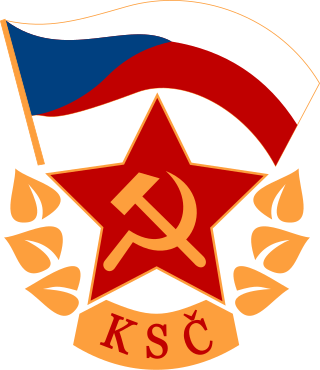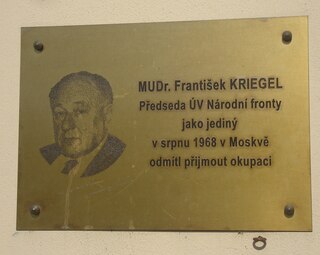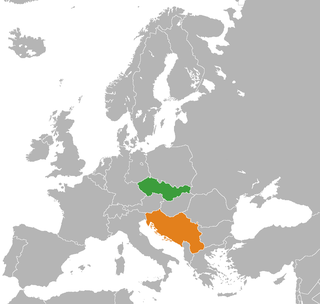| Part of a series on |
| Bulgarians Българи |
|---|
 |
| Culture |
| By country |
| Subgroups |
| Religion |
| Language |
| Other |
The Czech-Bulgarian relations date as far back as to the times of the Great Moravia.
| Part of a series on |
| Bulgarians Българи |
|---|
 |
| Culture |
| By country |
| Subgroups |
| Religion |
| Language |
| Other |
The Czech-Bulgarian relations date as far back as to the times of the Great Moravia.
Their importance rose especially during the time of the Czech National Revival of the 19th century and related ideas of Pan-Slavism. Among the pioneers of the Slavic studies (including the Bulgarian studies) were the Czech and Slovak personalities such as Josef Dobrovský, František Ladislav Čelakovský, Jan Kollár, Karel Jaromír Erben and foremost Pavel Josef Šafařík, who had close ties with Bulgarian students in Prague. His interest in Bulgarian history, language and nation helped to strengthen Bulgarian self-awareness. [1]
In 1862 the Bulgarian and Czech students in Prague established a secret society Pobratim in order to support Bulgarian independence movement against the Ottoman rule and to support the unification of the Slavic nations. In 1869 the Bulharská matice - The Postojanstvo Society was established in Tábor aiming for the same purpose. This was followed by the so-called Czech invasion into Bulgaria, of which Šafářík's grandson Konstantin Josef Jireček was the main personality. He took part in establishing the Bulgarian state services and became Bulgarian Minister of Education in the 1880s. Countless other Czechs took part in build-up of modern education and judiciary, cultural institutions as well as railways in Bulgaria. [2] Many Czech teachers, artists and qualified craftsmen took part in effort to build up Bulgarian state. [3] At the same time Czech industrialists established new undertakings in Bulgaria, foremost sugar refineries and breweries. Meanwhile, many Bulgarians immigrated to the Czech lands; mostly they were unskilled workers and young students wishing to obtain education at the Czech Universities.
In 1890 the first official Czech-Bulgarian association was established (Bulharská Sednjanka), while in the independent Czechoslovakia local associations grew in the large towns.
| Year | Pop. | ±% |
|---|---|---|
| 2011 | 7,435 | — |
| 2012 | 8,222 | +10.6% |
| 2013 | 9,132 | +11.1% |
| Source: [4] [4] | ||
Large numbers of Bulgarians escaped to Czechoslovakia after Bulgaria (at the time ally of Nazi Germany) was occupied by the Red Army at the end of the second world war. Thousands more benefited from joint program of governments of Czechoslovakia and Bulgaria in years 1946–8, in which whole families immigrated to the areas from which the Germans were expelled. Subsequently, many of these immigrants moved into larger cities, where they obtained jobs usually in industry.
During the socialist era the Bulgarian clubs were united under umbrella organisation Bulgarian Cultural Organisation. [5] The most friendly attitude of Czechs towards Bulgarians suffered hard blow as the Bulgarian army took part in the 1968 Invasion of Czechoslovakia.
{{citation}}: CS1 maint: location missing publisher (link){{citation}}: CS1 maint: location missing publisher (link)
The Prague Spring was a period of political liberalization and mass protest in the Czechoslovak Socialist Republic. It began on 5 January 1968, when reformist Alexander Dubček was elected First Secretary of the Communist Party of Czechoslovakia (KSČ), and continued until 21 August 1968, when the Soviet Union and most Warsaw Pact members invaded the country to suppress the reforms.

Demographic features of the population of the Czech Republic include population density, ethnicity, education level, health of the populace, economic status, and religious affiliations.

The Velvet Revolution or Gentle Revolution was a non-violent transition of power in what was then Czechoslovakia, occurring from 17 November to 28 November 1989. Popular demonstrations against the one-party government of the Communist Party of Czechoslovakia included students and older dissidents. The result was the end of 41 years of one-party rule in Czechoslovakia, and the subsequent dismantling of the command economy and conversion to a parliamentary republic.

The Czechs, or the Czech people, are a West Slavic ethnic group and a nation native to the Czech Republic in Central Europe, who share a common ancestry, culture, history, and the Czech language.

The Communist Party of Czechoslovakia was a communist and Marxist–Leninist political party in Czechoslovakia that existed between 1921 and 1992. It was a member of the Comintern. Between 1929 and 1953, it was led by Klement Gottwald. The KSČ was the sole governing party in the Czechoslovak Socialist Republic though it was a leading party along with the Slovak branch and four other legally permitted non-communist parties. After its election victory in 1946, it seized power in the 1948 Czechoslovak coup d'état and established a one-party state allied with the Soviet Union. Nationalization of virtually all private enterprises followed, and a command economy was implemented.

František Palacký was a Czech historian and politician, the most influential person of the Czech National Revival, called "Father of the Nation".

Konstantin Josef Jireček was an Austro-Hungarian Czech historian, politician, diplomat, and Slavist. He was the founder of Bohemian Balkanology and Byzantine studies, and wrote extensively on Bulgarian and Serbian history. Jireček was also a minister in the government of the Principality of Bulgaria for a couple of years.

Josef Jireček was a Czech scholar. He was born in Vysoké Mýto . He entered the Prague bureau of education in 1850, and became minister of the department in the Hohenwart cabinet in 1871. His efforts to secure equal educational privileges for the Slav nationalities in the Austrian dominions brought him into disfavour with the German element. He became a member of the Bohemian Landtag in 1878, and of the Austrian Reichsrat in 1879. His merits as a scholar were recognized in 1875 by his election as president of the Royal Czech Society of Sciences. He died in Prague on 25 November 1888.

Pavel Jozef Šafárik was an ethnic Slovak philologist, poet, literary historian, historian and ethnographer in the Kingdom of Hungary. He was one of the first scientific Slavists.

The Sokol movement is an all-age gymnastics organization first founded in Prague in the Czech region of Austria-Hungary in 1862 by Miroslav Tyrš and Jindřich Fügner. It was based upon the principle of "a strong mind in a sound body". The Sokol, through lectures, discussions, and group outings provided what Tyrš viewed as physical, moral, and intellectual training for the nation. This training extended to men of all ages and classes, and eventually to women.

Palacký University Olomouc is the oldest university in Moravia and the second-oldest in the Czech Republic. It was established in 1573 as a public university led by the Jesuit order in Olomouc, which was at that time the capital of Moravia and the seat of the episcopacy. At first it taught only theology, but soon the fields of philosophy, law and medicine were added.

Vojtěch Šafařík was a Czech chemist, specialising in inorganic chemistry. Šafařík was the son of Pavel Jozef Šafárik, a Slovak philologist and historian.

Lubor Niederle was a Czech archeologist, anthropologist and ethnographer. He is seen as one of the founders of modern archeology in Czech lands.

Czechsand Slovaks are a minority ethnic group in Bulgaria. According to the 2001 census, Czechs number only 316 and the number of Slovaks is even smaller, but historically, their population has been considerably larger.

On 20–21 August 1968, the Czechoslovak Socialist Republic was jointly invaded by four Warsaw Pact countries: the Soviet Union, the Polish People's Republic, the People's Republic of Bulgaria and the Hungarian People's Republic. The invasion stopped Alexander Dubček's Prague Spring liberalisation reforms and strengthened the authoritarian wing of the Communist Party of Czechoslovakia (KSČ).

František Kriegel was a Czechoslovak politician, physician, and a member of the Communist Party reform wing of Prague Spring (1968). He was the only one of the political leaders who, during the Warsaw Pact invasion of Czechoslovakia, declined to sign the Moscow Protocol.
A process of immigration of ethnic non-Bulgarians to Bulgaria began after the country's liberation from Ottoman rule and the restoration of the Bulgarian state in 1878. The first wave of immigrants, mainly from Central and Eastern Europe, brought skills needed in the creation of the new state. Later groups to arrive were Armenian refugees, White Russians, and foreign students. Since the fall of Communism and Bulgaria's entry to the European Union, immigration has increased, with many arriving legally or illegally from less developed countries, and since 2011 the country has been on a migration route used by Syrian refugees.

Czech Technical University in Prague (CTU) is one of the largest universities in the Czech Republic with 8 faculties, and is one of the oldest institutes of technology in Central Europe. It is also the oldest non-military technical university in Europe.

The Faculty of Arts, Charles University, is one of the original four faculties of Charles University in Prague. When founded, it was named the Faculty of the Liberal Arts or the Artistic Faculty. The faculty provides lectures in the widest range of fields of the humanities in the Czech Republic, and is the only university faculty in Europe which provides studies in all the official languages of the European Union. The faculty has around 1,000 members of staff, over 9,000 students, and a flexible system of more than 700 possible double-subject degree combinations.

Czechoslovakia–Yugoslavia relations were historical foreign relations between Czechoslovakia and Yugoslavia, both of which are now-defunct states. Czechoslovakia and the Kingdom of Serbs, Croats and Slovenes were both created as union states of smaller Slavic ethnic groups. Both were created after the dissolution of Austria-Hungary, itself a multinational empire unable to appease its Slavic populations or implement a trialist reform in its final years.